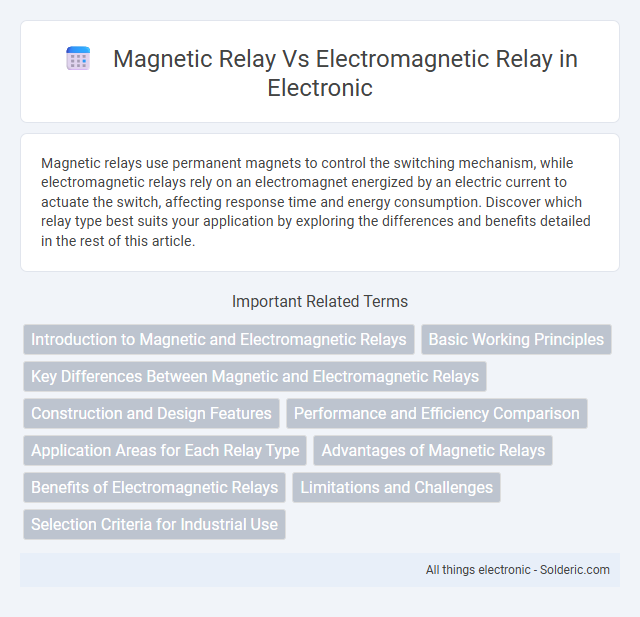Magnetic relays use permanent magnets to control the switching mechanism, while electromagnetic relays rely on an electromagnet energized by an electric current to actuate the switch, affecting response time and energy consumption. Discover which relay type best suits your application by exploring the differences and benefits detailed in the rest of this article.
Comparison Table
| Feature | Magnetic Relay | Electromagnetic Relay |
|---|---|---|
| Operation Principle | Uses magnetic field from permanent magnet | Uses magnetic field generated by electric current |
| Energy Source | No external power needed | Requires electrical power for coil excitation |
| Switching Speed | Slower switching speed | Faster switching speed |
| Control | Controlled by magnetic forces | Controlled by electric current through coil |
| Usage | Limited, mostly for specific magnetic sensing | Widely used in automation, circuits, and protection systems |
| Durability | Generally robust due to fewer components | Subject to coil wear and mechanical fatigue |
| Cost | Typically lower cost | Moderate to higher cost depending on design |
Introduction to Magnetic and Electromagnetic Relays
Magnetic relays operate by using a permanent magnet to maintain their switching position, enabling low power consumption and stable operation in control circuits. Electromagnetic relays rely on an electromagnet energized by a coil to create a magnetic field that moves the armature, allowing control of high power loads with electrical isolation. Both relay types serve distinct industrial and automation roles, with magnetic relays favored for simplicity and electromagnetic relays for versatility in switching high currents.
Basic Working Principles
Magnetic relays operate by using a magnetic field generated by an electric current to mechanically switch contacts, allowing the relay to control high-power circuits with a low-power signal. Electromagnetic relays specifically use an electromagnet coil that, when energized, creates a magnetic field to move an armature and open or close contact points, enabling circuit control. Understanding these basic working principles helps you select the appropriate relay for your electrical and electronic applications.
Key Differences Between Magnetic and Electromagnetic Relays
Magnetic relays operate using the magnetic field generated by a permanent magnet to switch contacts, while electromagnetic relays rely on an electromagnet powered by an electric current to create the magnetic field. The key differences include the magnetic relay's use of a constant magnetic field, which offers faster response times and lower power consumption compared to the electromagnet's varying magnetic field that requires continuous current to maintain operation. Understanding these distinctions can help you choose the right relay type for applications needing precise energy efficiency and switching speed.
Construction and Design Features
Magnetic relays and electromagnetic relays differ primarily in their construction; magnetic relays utilize permanent magnets to operate contacts while electromagnetic relays rely on an electromagnet powered by current flow. Magnetic relays feature a compact and durable design with fewer moving parts, making them suitable for applications requiring stable, vibration-resistant switching. Understanding these design features helps you select the appropriate relay type based on performance, size constraints, and operational environment.
Performance and Efficiency Comparison
Magnetic relays utilize permanent magnets to maintain contact positions, resulting in faster response times and lower power consumption compared to electromagnetic relays, which rely on energized coils. Electromagnetic relays generally offer higher switching capacity but consume more energy and may experience coil heating, affecting efficiency in continuous operation. Your choice depends on balancing performance needs against energy efficiency for reliable and cost-effective applications.
Application Areas for Each Relay Type
Magnetic relays are extensively used in low-power switching applications such as telecommunications, signal processing, and circuit protection, where precise and rapid response is essential. Electromagnetic relays find widespread application in industrial automation, power grid control, and motor protection due to their robust switching capabilities and ability to handle high current loads. Each relay type is optimized for specific use cases, with magnetic relays excelling in delicate electronic circuits and electromagnetic relays suited for heavy-duty electrical systems.
Advantages of Magnetic Relays
Magnetic relays offer faster switching speeds and greater durability compared to electromagnetic relays due to their solid-state components and absence of mechanical movement. Their compact design enhances reliability and reduces maintenance needs, making them ideal for high-speed or high-frequency applications. You benefit from increased efficiency and longevity when using magnetic relays in automated systems.
Benefits of Electromagnetic Relays
Electromagnetic relays provide high electrical isolation between the control circuit and the load, enhancing safety in applications. Their robust construction allows for reliable switching in high-current or high-voltage environments, ensuring durability under demanding conditions. These relays offer fast response times and precise control, which is essential for automation and protection systems requiring accurate timing and signal integrity.
Limitations and Challenges
Magnetic relays face limitations such as slower switching speeds and lower contact durability compared to electromagnetic relays, which can handle higher current loads and offer faster response times. Electromagnetic relays encounter challenges including susceptibility to electromagnetic interference (EMI) and higher power consumption due to continuous coil energization. Both relay types require careful consideration of operating environment, load characteristics, and coil voltage specifications to ensure reliable performance and longevity.
Selection Criteria for Industrial Use
Selecting between magnetic relay and electromagnetic relay for industrial use depends on load capacity, switching speed, and environmental conditions. Magnetic relays offer faster response times and lower power consumption, making them ideal for precision control systems, while electromagnetic relays excel in handling high voltage and current loads with robust mechanical durability. Your choice should consider the operational voltage, current ratings, and application-specific reliability requirements to ensure optimal performance.
magnetic relay vs electromagnetic relay Infographic

 solderic.com
solderic.com